Sabudana thalipeeth are crispy and soft pancakes made with tapioca pearls, mashed potatoes, ground peanuts and spices. These delicious sago pancakes are often made for Hindu religious fasting or vrat like Navratri, Ekadashi and Mahashivratri. They are also known as Upvasache Thalipeeth in the Marathi language.

Sabudana also known as sago or tapioca pearls are white colored small balls or pearls made from the roots of the cassava plant (tapioca, yuca).
Various Sabudana recipes are often made for Hindu fasting days. Usually I make Sabudana vada, Sabudana kheer or Sabudana khichdi during fasting.
You can make these sabudana thalipeeth instead of sabudana vada if you don’t want to eat any deep fried snack. Sabudana thalipeeth is a light snack and ideal for people who are fasting.
The way to make the mixture is same as sabudana vada. This mixture is then flattened and roasted or pan fried on a skillet or tawa. These are also known as Sabudana roti.
Serve the Sabudana thalipeeth or Upvasache Thalipeeth with any falahari chutney or raita. I served with vrat ke dahi aloo and tamarind dates chutney.
If you are looking for more Navratri Fasting Recipes then do check:
How to make Sabudana Thalipeeth
Soaking sabudana
1. Pick and rinse ⅔ cup sabudana well, till you get transparent water when rinsing. Soak them overnight or for 8 to 9 hours in enough water in a bowl.
Depending upon the quality of sabudana you can soak them for 2 to 3 hours also. I always soak them overnight as soaking for 2 to 3 hours doesn’t work for the quality of sabudana which I get in my city.

2. The next day, drain all the water really well. Make sure there is no water in them. It is an important step not to be missed.
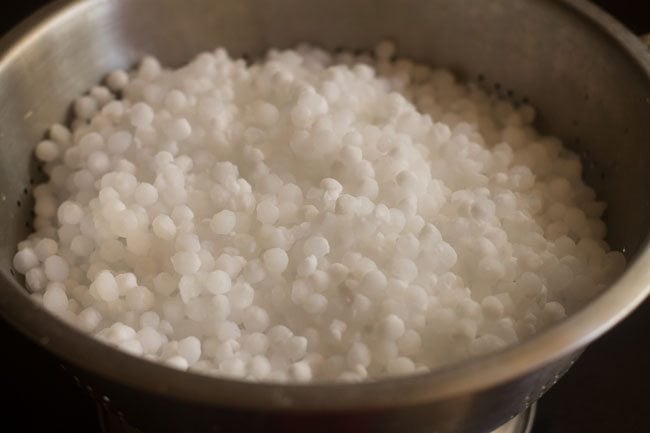
3. Measure and keep all the ingredients ready for making sabudana thalipeeth.

Making the sago mixture
4. Add 2 large or medium sized boiled, peeled and mashed potatoes to the soaked sabudana. Make sure that the mashed potatoes are warm or at room temperature.
Do not add hot mashed potatoes to the sabudana as this will partially cook the sabudana starch and make the mixture sticky.
You can cook the potatoes in a stovetop pressure cooker, pan, steamer or Instant pot adding water as required.

5. Next add the following ingredients:
- 1 teaspoon sugar
- ½ teaspoon cumin powder
- ½ inch finely chopped ginger
- sendha namak (rock salt) as required
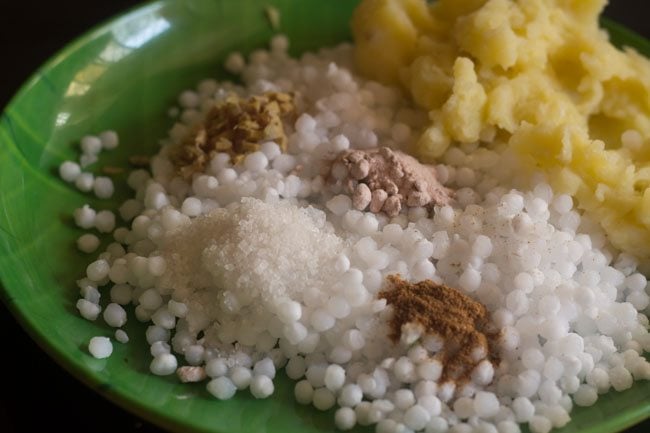
6. Also add ¼ cup chopped coriander leaves and ¼ cup coarsely ground roasted peanuts.
For the peanuts first roast ¼ cup peanuts in a pan or skillet until crunchy. Then once cooled, crush them to a semi-fine powder in a mortar pestle or spice grinder or mixer grinder.

7. Finally add 1 teaspoon lemon juice.
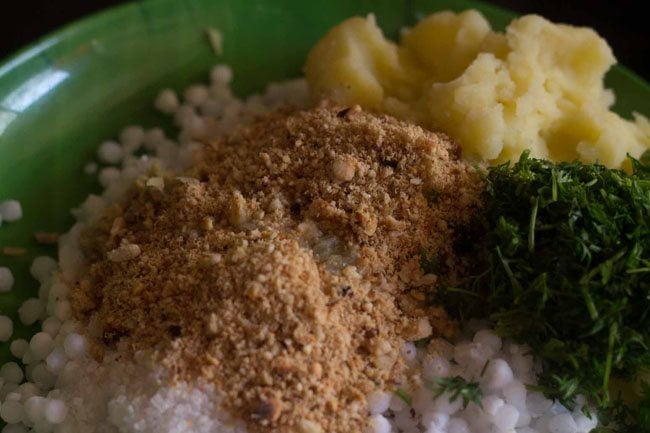
8. Mix very well to make an even mixture.

Cooking sabudana thalipeeth
9. Apply some peanut oil on your palms. Take some portion from the mixture and begin to flatten it with your palms to a round shape. you can also flatten on a ziplock bag. I find it easier to flatten with my palms.
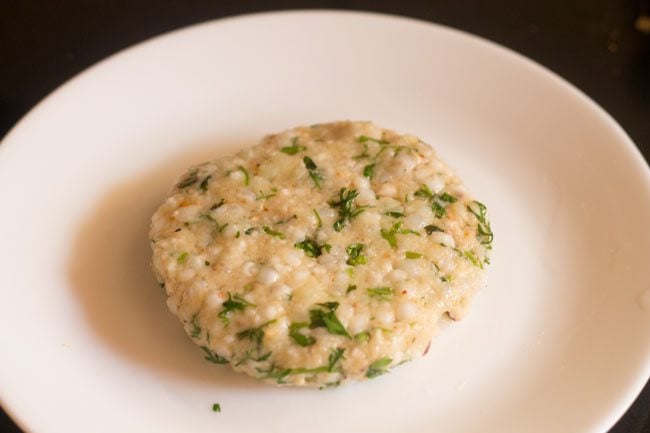
10. Heat a nonstick frying pan or a well seasoned cast iron skillet or tawa. Spread 1 or 2 teaspoon of peanut oil or ghee on the pan.
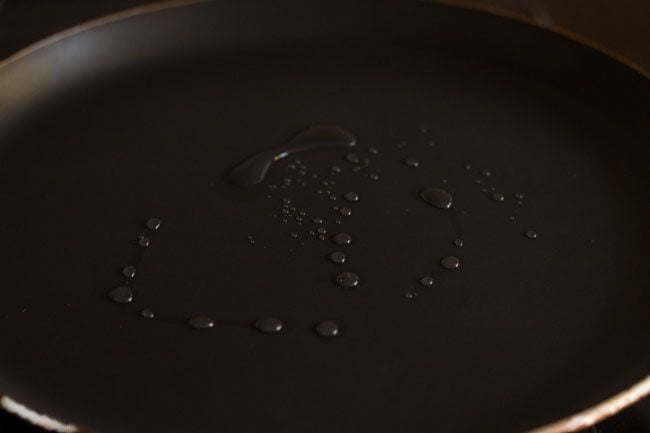
11. Place the flattened round (thalipeeth) on the frying pan. Keep the heat to medium low to medium.

12. When one side is golden and crisp then using a spatula carefully turn over. If you want you can drizzle or spread some peanut oil or ghee.

13. When this side also gets crispy and golden. Then flip once more if needed. You can flip a few times to ensure that the sabudana thalipeeth is cooked evenly and well.

14. If you have a large pan, you can cook 2 to 3 sabudana thalipeeth at the same time.
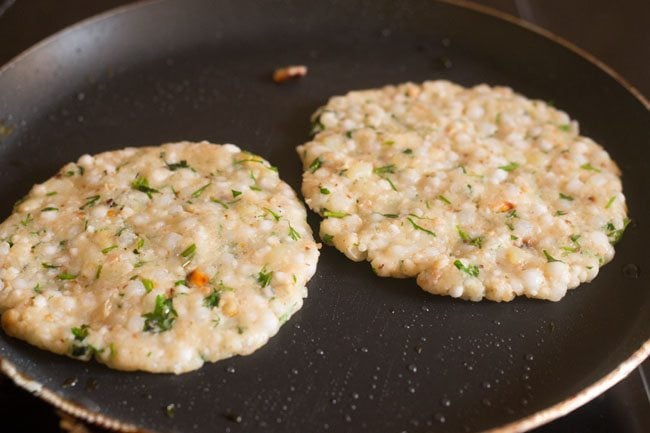
15. Repeat and similarly pan fry the rest of the thalipeeth.
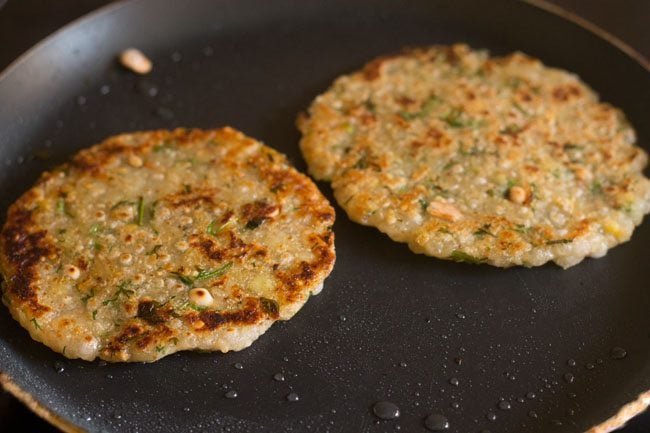
Serve sabudana thalipeeth with a phalahari chutney or raita or plain yogurt. You can also sweetened the curd with some sugar or jaggery.

Please be sure to rate the recipe in the recipe card or leave a comment below if you have made it. For more vegetarian inspirations, Sign Up for my emails or follow me on Instagram, Youtube, Facebook, Pinterest or Twitter.
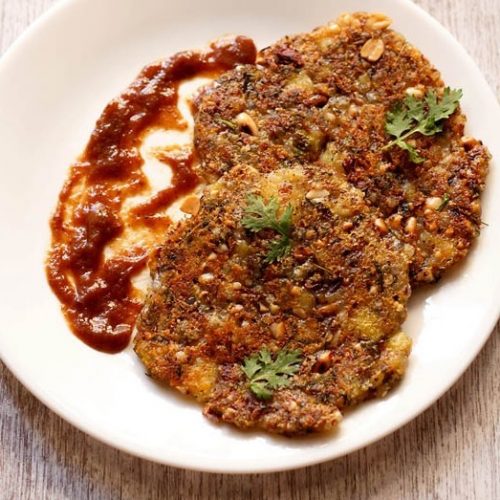
Sabudana Thalipeeth
Ingredients
- ⅔ cup sabudana (tapioca pearls)
- 2 medium or large potatoes – boiled, peeled and mashed
- ½ teaspoon cumin powder
- 4 tablespoon peanuts – roasted and coarsely ground
- ½ inch ginger – finely chopped or grated
- ¼ cup coriander leaves – chopped
- 1 teaspoon lemon juice
- 1 teaspoon sugar or add as required
- rock salt (edible and food grade) (sendha namak) as required
- peanut oil or ghee as required for pan-frying
Instructions
Soaking sabudana
- Pick and rinse the sabudana well till you get transparent water when rinsing.
- Soak them overnight in enough water in a bowl.
- The next day, drain all the water very well.
- Make sure there is no water in them.
Making sago mixture
- Add the mashed potatoes and all the ingredients to the soaked sabudana. Mix well.
- Heat a non stick frying pan or a well seasoned cast uron skillet or tawa.
- Spread 1 or 2 teaspoon of peanut oil or ghee on the pan.
- Apply some oil on your palms.
- Take some portion from the mixture and flatten it with your palms.
- You can also flatten on a ziplock bag.
Cooking sabudana thalipeeth
- Place the flattened round (thalipeeth) on the frying pan. Keep the heat to medium-low or medium.
- Fry till both sides are golden brown and crisp. Repeat.
- If you have a large pan, you can cook 2 to 3 thalipeeth at the same time.
Serving suggestions
- On fasting days, serve sabudana thalipeeth with any chutney or raita or homemade tomato ketchup made without onions and garlic.
- You can also have it with curd (yogurt) that has been sweetened with some sugar or jaggery.
- For non-fasting days, you can serve with a chutney or raita or tomato ketchup made with onions or garlic.
Nutrition Info (Approximate Values)
This Sabudana Thalipeeth post from the archives first published in April 2013 has been updated and republished on October 2021.









I tried this for the first time today, and it came out really well! Thanks for the recipe! I love your website and have been an ardent fan for the last decade. I just wanted to say I appreciate all the effort and love you put into this blog. Kudos to you and your team. Much love!!
Thanks a lot Namratha. Glad to know. Thanks for the review on the recipe and also for the rating. Take care.
can u use onions also?
shilpa, if making for fasting or vrat then don’t add onions. otherwise you can add onions.
Tried it, Delish!! Thanks for sharing all these fabulous recipes.
welcome nish and thanks.